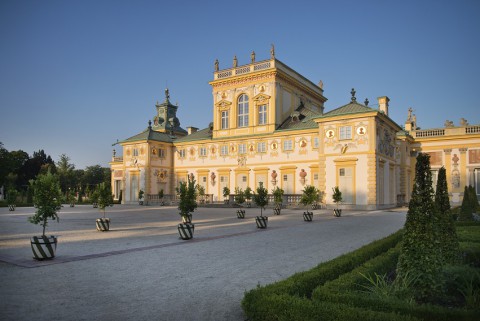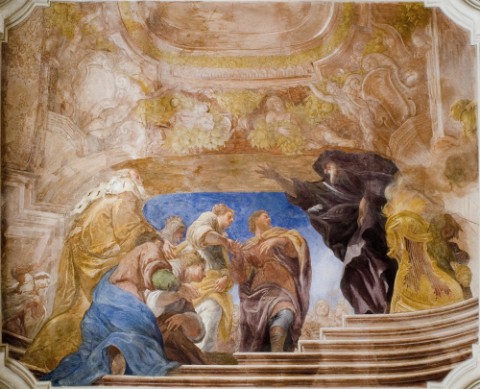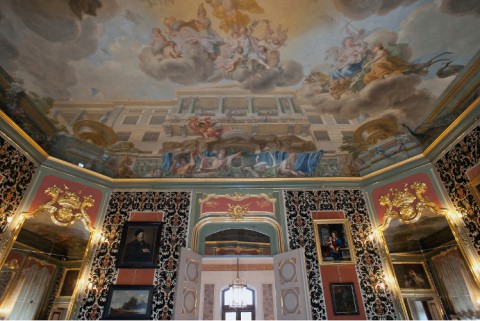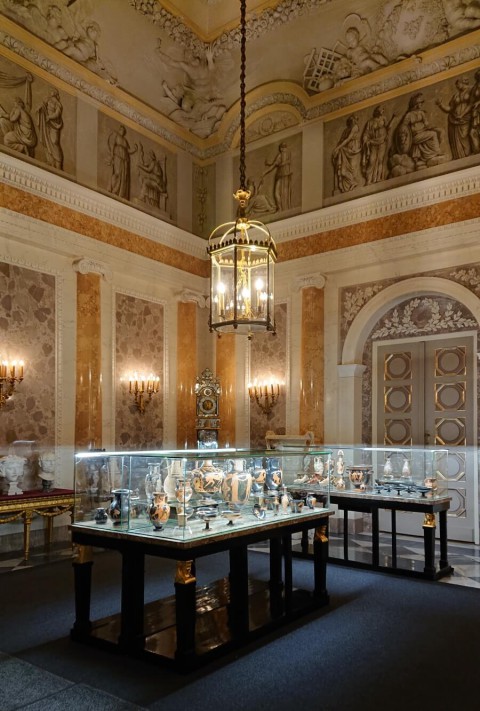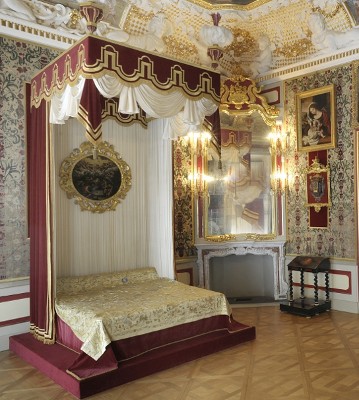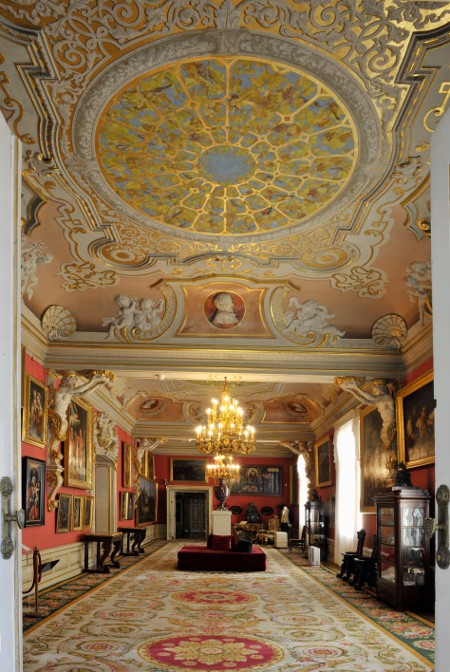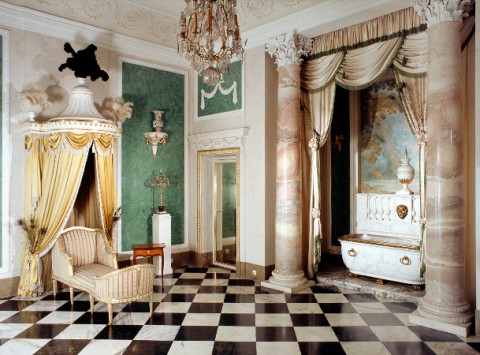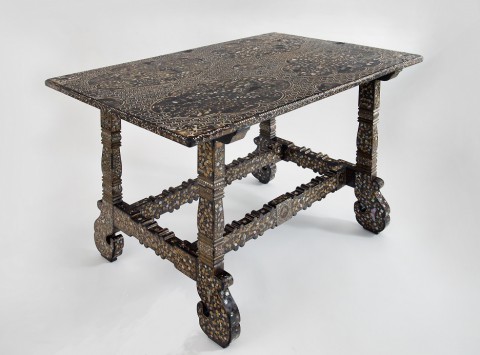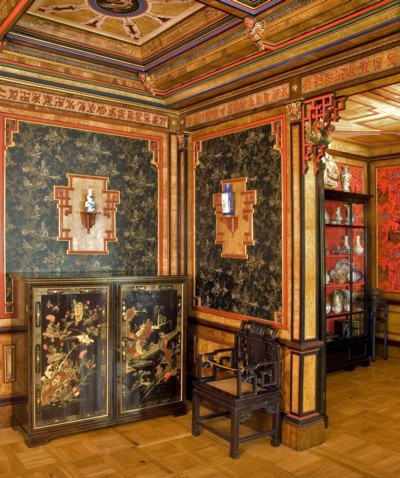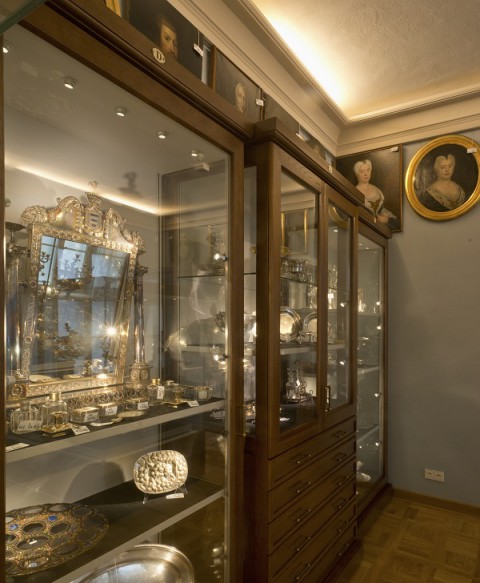What you can see in the palace
When Jan Sobieski accepted the royal title in 1676 and took the throne as Jan III, the Royal Castle, austere in its appearance, situated within the densely built-up Warsaw, became the seat of his court. Unaccustomed to the conditions of city life, the landowner king wanted to create a summer residence in the countryside that would give him the opportunity to enjoy peace, contact with nature and relaxation. In 1677, through the intermediary of the Master of the Horse Marek Matczyński, the king purchased the nearby village, known since the Middle Ages as Milanów. Immediately after the purchase, the new owner gave the village the Latin name Villa Nova, which was very quickly Polonised into Wilanów, perfectly matching the previous historical name. Jan III found the purchased Wilanów estate contained a “palace barely begun in the walls”, which he decided to expand. As a result of these works, the old Polish landowner’s manor transformed into a Baroque residence – majestic and representative. After the death of King Jan III, the next owner of the estate, Elżbieta Sieniawska, influenced the shape of the property. She ordered the construction of two side wings, which gave the palace its characteristic horseshoe shape. A later significant change was the addition of the so-called Izabela Lubomirska’s Bathroom at the end of the southern wing, on a plan approximating a square. The Wilanów Palace together with the picturesque garden and park form a popular Baroque type of regular, axial structure situated between the representative honorary courtyard and the garden (the so-called entre cour et jardin).
During more than 300 years of the history of the Wilanów Palace, its successive owners extended the residence and introduced changes to it in accordance with the prevailing fashions. Despite this, the palace has retained its original character, reflecting the still vivid memory of its first owner, King Jan III.
Currently available to visitors are: the White Hall, the South Gallery, the King’s Library with a temporary exhibition of plafonds, Royal Apartments with the Dutch Cabinet, Hall of Marszałkowa Lubomiska, new exhibition space with a Nanban table, Chinese and Hunting Rooms, The Storage Accessible for Visitors, new exhibition on the first floor of the palace on the collector's fascinations of the Potocki family.
Route 1
Note: at present, the rooms of former Potocki Museum are temporarily unavailable to visitors due to the necessary conservation works. Currently, the following rooms are available to visitors: the White Hall, the South Gallery, the King's Library with a temporary exhibition, and the Royal Apartments with the Dutch Cabinet.
The White Hall
In 1730, when the Wilanów estate was held by King Augustus II the Strong from the Wettin dynasty, a representative White Hall was established. This largest and most magnificent interior in the palace has witnessed many important ceremonies. Today, its décor refers primarily to the shape of the hall in the 19th century. Collected here are paintings of successive owners of the palace or persons associated with it. The magnificent Equestrian Portrait of Stanisław Kostka Potocki by Jacques-Louis David is one of the most important foreign works of art in the Polish collection.
Garden Galleries
The North and South Galleries were originally galleries open to the garden. Their decorations include high quality frescoes by Florentine artist Michelangelo Palloni, showing the amorous tribulations of Cupid and Psyche. The story refers to the feelings that united Jan Sobieski and Marie Casimire. In the original design, a small room, now a Lapidarium (room with antiquities), was part of the South Gallery, so it is here that the first scene from the mythological story can be found on the ceiling.
Apartments of King Jan III
The king’s apartments consist of the Library, Antechamber, Bedroom, Chinese Cabinet and Wardrobe. Initially, the King’s Library housed a rich collection of the king’s books, later moved to his family estate in Żółkiew (now Zhovkva, Ukraine). To this day, a thematic catalogue of the books has been preserved, located on the ceiling and partially on the walls. It consists of circular portraits of the most famous artists and thinkers of the ancient and early modern times. Under each of them there was a bookcase with books that thematically corresponded to the discipline of the person portrayed. Also noteworthy is the three-coloured marble floor, which uses the illusion effect. This is the only original floor in the palace dating back to the time of King Jan III! The Antechamber functioned as a representative hall, where the courtiers waited for an audience with the king. In accordance with Baroque customs, such meetings were often held in camera, i.e. the King’s Bedroom. The decoration of these rooms confirmed the guests’ belief in the ruler’s majesty. During the audience, the king would lie in a ceremonial bed while the visitors would remain standing. Only the closest family and the most distinguished guests were permitted to sit in the company of the ruler, which was also a characteristic element of the 17th century custom. The preserved decorations of the ceilings of the Antechamber and the King’s Bedroom are among the most valuable monuments of Baroque art in Poland. The plafond paintings – Winter (Antechamber) and Summer (Bedroom) – were made by Jan III’s court painter – Jerzy Eleuter Szymonowicz-Siemiginowski. There are two small rooms in the alcoves: Wardrobe and Chinese Cabinet. In the second half of the 17th century, there was a fashion for Far East motifs (the so-called “Chinoiserie”) in Europe. King Jan III also succumbed to it, arranging one of his private offices in this fashion. Today’s décor of the Chinese Cabinet is the result of the rearrangements from the times of Augustus II – during this time, wonderful decorations made in the European lacquer technique, was made by the monarch’s court artist, Martin Schnell.
The Dutch Cabinet
The Dutch Cabinet was originally used to exhibit works by Dutch masters, including Rembrandt himself. The present arrangement of the room, including the monumental ceiling fresco Apotheosis of Prosperity and Development of Sciences and Arts Under Saxon Rule, dates back to the times of King Augustus II. The painting presents a characteristic Baroque type of illusionist painting called quadratura.
The Grand Vestibule and Equestrian Monument to Jan III
During the reign of Jan III, the Grand Vestibule was one of the most representative and monumental rooms in the palace. For many years it served as a dining room – at that time, its decoration was richer, but it has not been preserved in its entirety to this day. Currently, visitors can admire the ceiling stucco decoration of the coving that shows the four elements and the four mythological winds. Across from the main entrance to the palace, in the niche between the columns, the equestrian monument to Jan III one stood – one of the many elements of glorification of the great victor of the Battle of Vienna. Presently, the monument is located near the south tower, at the entrance to the gallery.
Queen Marie Casimire’s Apartments
The Queen’s apartments consist of the Antechamber, Bedroom, Al Fresco Cabinet, Antecabinet and the Mirror Cabinet. The layout of the queen’s room is a symmetrical reflection of the king’s apartments: The Antechamber served as a vestibule, the Bedroom (Chamber), in addition to its basic function was a room of representative character, while the adjacent small cabinets were private rooms. The Queen’s Bedroom is undoubtedly one of the most impressive rooms in the palace. Particularly noteworthy is the ceiling painting (plafond) portraying an allegory of Spring, painted by Jerzy Eleuter Szymonowicz-Siemiginowski. The figure of the goddess Flora portrayed in the plafond is based on Queen Marie Casimire. The coving is decorated with representations of the mythical Sphinx, whose task was to guard the queen’s sleep. In the Antechamber, the plafond painting shows a representation of Autumn, completing the series of the four seasons. Preserved in the corner Mirror Cabinet is a plafond by Jan Reisner with an image of Aurora, which contains crypto-portraits of Marie Casimire and her sons. The Al Fresco Cabinet is decorated with original 17th-century wall paintings imitating stone portals and draped wall tapestries with mythological scenes featuring Apollo. The decoration was uncovered by conservators in 1955 – prior to this, a wooden staircase leading to the upper palace level was located here.
The Potocki Museum
Stanisław Kostka Potocki – politician, collector and archaeologist, sometimes known as the Polish Winckelmann – was the owner of Wilanów in 1799–1821. In 1805, he made his art collection, accumulated at the palace in Wilanów, available to the public. This was the creation of the first art museum available to everyone in Warsaw (second in Poland). The North Gallery was adapted for displaying paintings, sculpture and artistic craft. As in the Lapidarium, the Etruscan Cabinet was used to display the collection of antiquities gathered by the Potocki family. Presently, there are over 100 antique vases here, from the area of southern Italia, Etruria and Athens.
The Painting Gallery, known as the Museum, as well as the Landscape Gallery were adapted into a pinacotheca presenting Italian, French, Flemish and German paintings. The walls were painted Pompeii pink, a colour often used in 19th-century museum interiors, because it was an excellent background for the paintings on display. The small Cabinet before the Gallery contains European paintings from the collection of Stanisław Kostka Potocki. Mounted in the threshold of the room is a plaque with a Latin inscription: Cunctis patet ingressus (entrance free for all); this was how the museum founder’s merits were emphasised by his grandson, August Potocki.
Note: at present, the former Potocki Museum is temporarily unavailable to visitors due to the necessary conservation works. Selected works of art from the painting collection are presented on the first floor of the palace.
Cabinets of Antiquity
The currently presented, consolidated collection of ancient vases and Egyptian collections allows us to see them in the form that Stanisław Kostka Potocki planned: in the historical interiors of the palace, historical wardrobes and against the background of the restored set decorations. Note: currently the Cabinets of Antiquity are temporarily unavailable to visitors. We present selected works of ancient art in the Great Vestibule.
Route 2
Note: currently selected rooms on route 2 are temporarily unavailable to visitors. The following rooms are available to visitors: The Princess Marshall Lubomirska’s Anteroom, a new exhibition space with a Nanban table, Chinese and Hunting Rooms, the Storage Accessible for Visitors.
The Princess Marshall Lubomirska’s Apartments
Anteroom, Parlour, Golden Bedroom and the Bathroom comprise the private rooms of Izabela Lubomirska – the owner of the palace in 1771–1799. Lubomirska, also known as the Blue Marquise for her love of gowns in the colour, had a strong character and excellent artistic taste. She arranged the interiors of her private apartments in accordance with the latest trends in art. The Bathing Pavilion, where the main element is a free-standing marble bathtub, was a place of care and rejuvenation treatments for its owner.
Nanban table
A new exhibition commemorating the collector's passions of Stanisław Kostka Potocki and his descendants was opened at the hallway adjacent to the Chinese and Hunting Rooms. In the exhibition, we present objects from the Wilanów Far East collection, previously hidden in warehouses. Visitors are able to admire craftsmanship products made of ceramics, glass, as well as lacquers and mixed techniques. An important part of the exhibition is the presentation of a unique table in the nanban style, made in the 17th century in Japanese workshops, which regained its shine thanks to careful conservation, preceded by tests conducted by specialists in the workshop of the Museum of King Jan III’s Palace at Wilanów. The exhibition is enriched with educational content related to the history and conservation of this unique piece of furniture, presented at a modern multimedia stand.
Chinese and Hunting Rooms
The decorations of the Chinese and Hunting Rooms date back to the 1880s; at that time, they were the private apartment of the palace owners. The Wilanów tradition of decorating interiors with motifs inspired by Oriental art was continued here. Today, the rooms hold furniture in the Chinese style and the Wilanów collection of Far Eastern art. The rooms refer to the 19th-century collectors’ cabinets, which held rich collections of various objects that interested and fascinated collectors and scientists. Most of the objects gathered here are export goods – manufactured in the Far East especially for the European market, adapted to European tastes and expectations. Many objects bear clear traces of mutual influences and inspirations of European and Far Eastern art., The name of the Hunting Rooms in the Wilanów Palace is connected primarily with their stylised décor, referring to the aesthetics of 19th-century hunting palaces. The walls are covered with painted faux wood grain cladding. In the second half of the 19th century it was the study of August Potocki, for whom hunting – as for most men of that time – was a rather frequent entertainment. The furnishings of the hunting apartment were not preserved in the Wilanów Palace. The interior design presented today uses works and objects with a hunting theme from various eras, which are now part of the Wilanów collection.
Silver collection
Part of the gallery of artisanal craftsmanship is the temporary exhibit of silver from the Wilanów collection, made available in one of the restored Hunting Rooms. Due to the limited exhibition area, only selected elements representing larger sets are displayed. These are exclusively utility objects from the turn of the 18th and 19th centuries, created in the workshops of outstanding French and Polish goldsmiths.
The Storage Accessible for Visitors
The Storage Accessible for Visitors is an exhibition space created in the Markoniówka – a small three-storey building adjacent to the south wing of the palace. The unique character of the exhibition of the Storage Accesible for Visitors allows for the presentation of valuable works of art, which for many reasons have not been shown for years. It houses an exclusive collection of goldsmiths’ goods, original wall fabrics from royal apartment and a collection of objects from the Far East, including works decorated with several types of lacquer, enamelled metal dishes, a rich collection of porcelain, as well as water-colour paintings on paper. The modern space of the pavilion has been equipped with specially designed display cases allowing visitors to see delicate exhibits from a very close distance.
Note: The upper level of the palace is currently partly unavailable to visitors.
Residential rooms on the mezzanine
The Anteroom, Middle Room and Quiet Room are all residential spaces. The Anteroom, or as it was known in the 19th century, the First Room, is covered with illusionist Baroque paintings: architectural elements open to the landscape. What is surprising is the signature left by the author, Giuseppe Rossi – he placed his portrait in one of the corners. The Middle Room, originally intended for royal children and located in the central section of the main body of the palace, is a typical interior of an old Polish noble’s house. The characteristic wooden ceiling is decorated with polychromes with the coats of arms of Jan III and Marie Casimire, royal crowns and laurel wreaths. The furnishings from the time of King Jan III have not been preserved. The Quiet Room is located directly above the King’s Bedroom; hence its name refers to discreet behaviour. The room also served as a guest apartment.
Locci Rooms
Two corner cabinets located in the north-eastern alcove were the rooms of Augustyn Locci, the court secretary and head builder of the palace. Special attention should be paid to the 17th-century beam ceilings with painted ornaments and wall frescoes portraying idyllic landscapes.
Faience Cabinet
Along with the adjacent Three Windows Cabinet, it served as a residential space. The Faience Cabinet owes its name to the faience tiles that decorate the walls. In the Baroque era, this was an extremely expensive and fashionable decoration, seen in European magnate courts. Most frequently, the tiles were decorated with genre scenes; here, the main motif are stylised vases. The tiles are dated back to 1690 and come from the Netherlands, which at the time was a famous European centre of high-quality faience production. The whole is crowned with a dome that features coffers and a fresco that uses the Baroque illusion effect.
Banqueting Hall of King Jan III
Located on the highest floor of the Palace is the Banqueting Hall of King Jan III, added in the third stage of the Wilanów Palace expansion, still during the lifetime of Jan III (died 1696). Over the centuries, it served various functions: representative, viewing, dining room, billiard room (during the time of Izabela Lubomirska), as well as the Great Library Hall of the Potocki Family. The illusionist fresco paintings revealed under the plaster were created in 1724 by Giuseppe Rossi. The entrances to the hall are decorated with overdoors, one of which, bearing the Latin inscription Vitae discendum et patriae (one must learn for life and homeland), is dedicated to the memory of Stanisław Kostka Potocki, while the other, with the inscription W każdej doli mistrzyni (a mistress in every fate), is dedicated to his brother, Ignacy.
Photographs by: Wojciech Holnicki, Zbigniew Reszka.
suggested

What you can see in the park
Wilanów Palace & ParkLocated south of Warsaw, the Wilanów Palace & Park concludes the series of royal residences erected on …

Opening hours
PalaceFor individual visitors the Wilanów Palace is open:from January 8, 2024 – every day from 10.00 to 16.00 (last admission: …

Regulations for visitors to the Palace and exhibitions at the Museum of King Jan III's Palace at Wilanów
1. You are welcome to visit us:a) on Mondays, Tuesdays, Fridays, Saturdays and Sundays between 10.00 a.m. and 4.00 p.m. …


